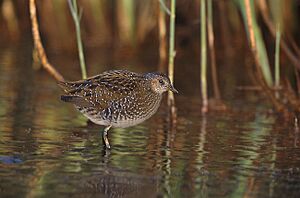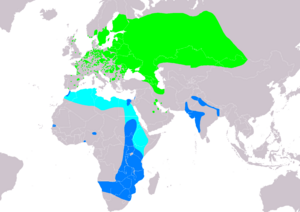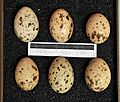Spotted crake facts for kids
Quick facts for kids Spotted crake |
|
|---|---|
 |
|
| Conservation status | |
| Scientific classification | |
| Genus: |
Porzana
|
| Species: |
porzana
|
 |
|
| Range of P. porzana
Breeding Passage Non-breeding |
|
| Synonyms | |
|
Ortygometra porzana (Linnaeus, 1766) Rallus porzana Linnaeus, 1766 |
|
The spotted crake (Porzana porzana) is a small waterbird. It belongs to the Rallidae family, which includes water rails and coots. These birds are known for living in wet, marshy places.
Contents
About the Spotted Crake
The spotted crake is a small bird, about 19 to 22.5 centimeters (7.5 to 9 inches) long. It's a bit smaller than a water rail. You can tell it apart by its short, straight bill, which is yellow with a red base.
What do they look like?
Adult spotted crakes have mostly brown feathers on their upper body. Their chest is a pretty blue-grey color. Their sides have dark stripes and white spots. They have green legs with long toes, which help them walk on soft mud. Their short tail is a light brown underneath.
Young spotted crakes look similar to adults. However, their blue-grey chest feathers are replaced with brown ones. Baby crakes, called chicks, are completely black. This is common for all rail birds.
Where do they live?
Spotted crakes breed in marshes and areas with lots of sedge plants. These places are found across temperate Europe and into western Asia. They build their nests in a dry spot within the marsh plants. A female crake usually lays between 6 and 15 eggs.
Their amazing journey
These birds are migratory. This means they travel long distances each year. They spend their winters in warmer places like Africa and Pakistan.
What do they eat?
Spotted crakes use their bills to search for food in mud or shallow water. They also pick up food they see. Their diet mainly includes insects and small animals that live in water.
Sounds and secrets
Spotted crakes are very shy, especially during the breeding season. It's rare to see them then. You are much more likely to hear them! They make a loud, repeated call that sounds like hwuit, hwuit. It's a bit like a whip cracking. They can be easier to spot when they are migrating.
Conservation efforts
The spotted crake is part of an important agreement. This agreement, called the Agreement on the Conservation of African-Eurasian Migratory Waterbirds (AEWA), helps protect birds that migrate across Africa and Eurasia. Sadly, the number of spotted crakes in Western Europe has gone down in recent years. Because of this, they are now a very rare breeding bird in Great Britain.
Gallery







